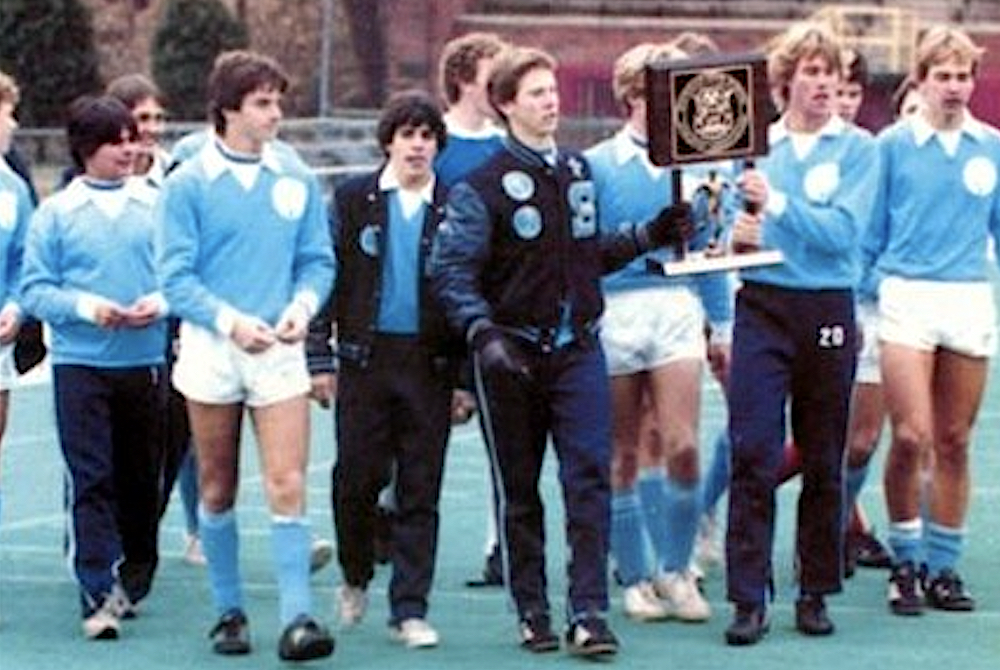
'World's Game' Makes Home in Metro Detroit, Then Grows Statewide
By
Ron Pesch
MHSAA historian
November 3, 2021
In the fall of 1982, Livonia Stevenson assistant coach Ralph Aulicino suggested to Detroit Free Press stringer Jon Pepper that “somewhere along the Livonia city limits” there should be a sign erected that proclaimed the Detroit suburb as “the state capital of soccer.”
Stevenson’s Spartans had just beaten crosstown rival Livonia Churchill 4-1 in what some called “The Battle of Livonia.” The contest, played at Flint’s Atwood Stadium, was the first-ever Class A Boys Soccer Final sponsored by the Michigan High School Athletic Association.
Guided by head coach Pious (Pete) Scerri, a former first division player in England, Stevenson finished the year with a flawless 22-0 record. Gary Mexicotte scored twice for the Spartans in the title game, finishing with 48 goals on the season. In December, he was named prep All-American.
Aulicino’s statement might have been considered a bit arrogant within the soccer community. Still, there was little question that the surrounding burgs of the Motor City were the hub of the prep soccer world in Michigan at the time.
The Hamtramck Cosmos, coached by John Geremich, finished with the MHSAA’s Class B-C honor while Grosse Pointe Woods University Liggett, coached by David Backhurst, earned the Class D trophy in the autumn tournament. The Knights finished the year with an 18-1-1 mark, and would repeat as champs in 1983, but this time in Class B-C.
Dominant
Looking back today, Aulicino’s words were prognostic.
In the spring of 1983, Stevenson’s girls, coached by Norene Divens, grabbed the MHSAA’s first Open Class championship – meaning schools of all sizes competed in one division – with an 8-0 win over Saginaw Eisenhower.
Then Scerri’s boys would appear in an incredible six of the first seven Class A title games, winning four. Divens’ girls appeared in the first three Open championships, winning two while finishing runners-up to Northville in a 5-4 overtime battle in 1984. Churchill’s girls won the 1986 Open title. When the MHSAA expanded the girls postseason to two divisions, Churchill finished runner-up in Class A to Plymouth Salem – yet another metro Detroit high school – in the springs of both 1987 and 1988.
Allen Park Inter-City Baptist won three straight boys Class D titles from 1983 to 1985.
Coach Scerri did emphasize the importance of the moment to the development and changing landscape of sports in Michigan following that first championship:
“Let me put it this way. Usually, we get the rejects from the football team. This year, the football team took three rejects from us. It’s going the other way around now.”
Culinary Delights, Old World Music, and Soccer
The chance to play for an MHSAA Finals title must have been a joyous occasion in the vibrant community of Hamtramck. Geremich, whose team won that first Class B-C championship, explained the city’s connection to the sport in 1980.
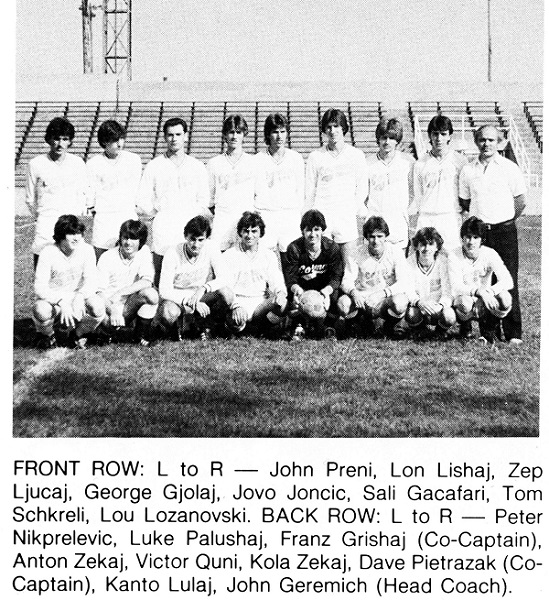 “We’ve got a lot of Yugoslavian and Albanian kids who were brought up on soccer,” he told the Free Press. “Their parents never played football and baseball, so they look to soccer.”
“We’ve got a lot of Yugoslavian and Albanian kids who were brought up on soccer,” he told the Free Press. “Their parents never played football and baseball, so they look to soccer.”
Geremich himself was one of those kids. He came to America in 1958 from Serbia and attended Hamtramck. Soccer, however, wasn’t an option at Hamtramck during his days in high school.
Without that outlet, Geremich along with classmates Francisco ‘Pancho’ Castillo from Colombia and Jerry Podesek from Poland, all became standouts in the school’s outstanding tennis program instead. The Cosmos won 11 consecutive MHSAA Class A team tennis state titles from 1949 to 1959, and 18 of 21 between 1949 and 1969. The trio would later attend and play tennis at Southern Illinois University together.
“All three readily admit that soccer and not tennis are the national pastimes in their homelands,” stated the Grand Rapids Press in 1958.
Hamtramck’s top player in 1982 was Kanto Lulaj, who had been playing soccer since the third grade. Only a few years earlier, his family had come to Hamtramck from Albania. A 150-pound junior center-forward, he finished that championship season as Michigan’s most prolific scorer, notching 56 goals. A four-year varsity starter, he was named All-American in 1983, then played collegiately at the University of Connecticut.
Pockets
Delving into the game’s earliest history at the prep level in Michigan certainly helps explain the area’s dominance. Wildly popular among the immigrant population employed in plants across southeastern Michigan, men’s factory and recreational soccer leagues flourished in and around Detroit for years.
The Holley Carburetor F.C. team, sponsored by Detroit’s Holley Brothers Company, gained coast-to-coast attention as it battled to the National Challenge Cup championship game (today known as the Lamar Hunt US Open Cup), played before 10,000 fans at University of Detroit stadium in May 1927. A Detroit professional circuit even came into existence that same year. The short-lived Detroit Cougars, according to the Free Press, were the first incorporated soccer club in Michigan.
“School soccer enjoyed a successful season,” said the Free Press in 1928, “especially in the elementary and intermediate grades, in which more than 17,000 boys participated in the schedule formulated by the health education department of the Detroit public schools.”
Ultimately, the increasing popularity of American football among boys (and spectators) overwhelmed soccer within public school districts, and soccer never became much more than an activity played outside school, or perhaps sometimes during gym class.
 Soccer, or at least a form of the game, did appear as an intramural athletic activity in girls gym classes across the state dating back into the 1920s. Occasionally, especially in small towns, contests were played between schools from neighboring districts. For example, Buchanan’s senior girls defeated the sophomore girls from their old rival Niles, 2-0, in 1928.
Soccer, or at least a form of the game, did appear as an intramural athletic activity in girls gym classes across the state dating back into the 1920s. Occasionally, especially in small towns, contests were played between schools from neighboring districts. For example, Buchanan’s senior girls defeated the sophomore girls from their old rival Niles, 2-0, in 1928.
As state and national debate grew concerning the capacity and value of athletic activity and competition amongst girls, the sport was often modified within districts. At Ludington, speedball replaced soccer in 1948-49. At Birmingham Seaholm in 1962, girls participated in speed-o-way, a game similar to soccer that allowed use of the hands.
A Spark
Prep soccer programs found a spark among the boys at select schools in the suburbs of Detroit during the late 1950s and early 60s.
“(Initially) the only people that were playing anything approaching league soccer were the private schools,” recalled John Sala, a former coach at Birmingham Groves.
These programs were started as club sports, representing a school, but generally run outside the finances, guidance, and official sponsorship of a school’s athletic department. Opponents came where they could be found.
School yearbooks from the past help tell the tale.
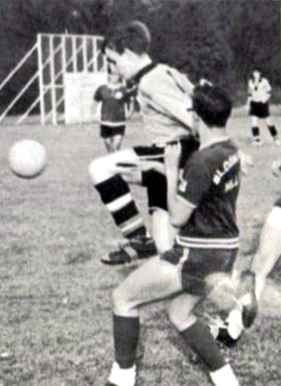 The sport was played at Bloomfield Hills Cranbrook in the 1930s, 1940s, and 1950s with games played against other private schools in Canada, Ohio, Illinois, western New York state, and Pennsylvania. Michigan schools first began appearing on the schedule in the 1960s.
The sport was played at Bloomfield Hills Cranbrook in the 1930s, 1940s, and 1950s with games played against other private schools in Canada, Ohio, Illinois, western New York state, and Pennsylvania. Michigan schools first began appearing on the schedule in the 1960s.
The team at Grosse Pointe University School (GPUS), according to its 1964 annual, “was founded five years ago by Mr. Preston, who returned this year to coach it.” The season was comprised of only six games, played against three opponents – Cranbrook, Bloomfield Hills and a season-ending game with “Preston’s Ringers.”
“With soccer only in its second year as a Varsity sport … the 1965 team showed a promise of successful seasons to come,” read the Bloomfield Hills High School yearbook. The boys finished the year with a 5-3-1 record. “Since soccer has yet to become a league sport,” the Barons faced squads from Cranbrook, GPUS, and Oakland University, as well as teams from Lowe Tech and Sarnia, both from Ontario, Canada.
Soccer became a varsity sport at Detroit Country Day School in 1965. That team finished with a 3-2-3 mark, playing contests with GPUS, Maumee, Ohio, and a newly-formed club team from Groves:
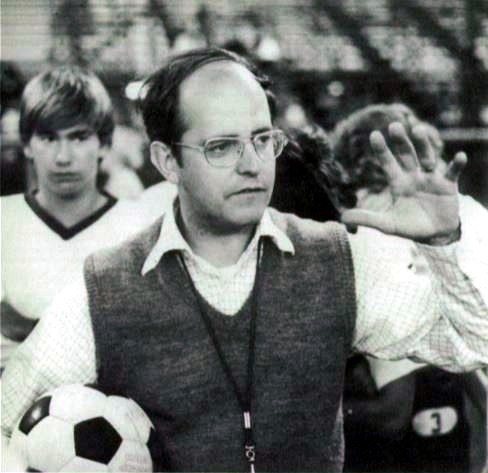 “After a late start in practice because they lacked a coach and equipment, Groves’ first soccer team introduced the rugged game to Birmingham varsity sports. Mr. John Sala took over coaching duties and helped the boys make the transition from last year’s club status to a varsity team with a full season schedule. The arrival of goals and other equipment and the donation of uniforms by Mr. Harrison Tracy boosted team morale and their play improved noticeably.”
“After a late start in practice because they lacked a coach and equipment, Groves’ first soccer team introduced the rugged game to Birmingham varsity sports. Mr. John Sala took over coaching duties and helped the boys make the transition from last year’s club status to a varsity team with a full season schedule. The arrival of goals and other equipment and the donation of uniforms by Mr. Harrison Tracy boosted team morale and their play improved noticeably.”
“When I was at Groves and starting out coaching (in 1966), I knew absolutely nothing other than having watched it,” recalled Sala, laughing at the memory. “They had a club team run by another staff member … and he left. Basically, they called me down to the office … I thought I was going to get reprimanded. (Instead) she says, ‘We have to have a coach by 4:00 today.’ I said, ‘How much does it pay?’ She said ‘$300.’ It sounds like a lot of money to me. So, I learned by doing.”
Sponsorship of soccer soon spread to other public schools in the immediate area, with teams appearing at Bloomfield Hills schools Andover and Lahser, the Livonia schools, Birmingham Seaholm, and Ferndale.
West Michigan
On the other side of the state, the soccer seed was taking root in the Greater Grand Rapids area.
“Central Christian, champion of the Christian High School Soccer League, completed its season Saturday morning at Calvin College’s Knollcrest Field by defeating Holland Christian, 3-1,” stated the Grand Rapids Press in October 1966. The four-team league also included Hudsonville Unity Christian and Grand Rapids Calvin Christian.
A year later, Kalamazoo Christian was added to the league, then Muskegon Western Michigan Christian (WMC). Casey Ver Haar, an honorable mention All-American goalie in soccer at Calvin College, coached Central Christian. Dave VerMerris, a former track star at Central Christian, then at Calvin College, took the job at WMC as coach at age 22. He had first given soccer a try as a freshman in college.
 “Calvin that year had graduated quite a few of their soccer players,” recalled VerMerris, explaining how that began. “(Several) of their soccer players were immigrants – Dutch immigrants. They were hurting for bodies …”
“Calvin that year had graduated quite a few of their soccer players,” recalled VerMerris, explaining how that began. “(Several) of their soccer players were immigrants – Dutch immigrants. They were hurting for bodies …”
Marv Zuidema, the soccer coach, approached VerMerris sometime in August of 1964 and suggested he give the sport a try.
“I had some speed back in those days, and speed can take care of a lot of things if you don’t have the skill,” said VerMerris, chuckling. “His dream was I would outrun their defense and put the ball in the net. That never happened.”
Sport of the Future
Christian League officials were pleased with the level of competition and attendance at games. Between 100 and 150 spectators were showing up for contests.
“While (the) majority of West Michigan schools compete in nine major sports now,” noted longtime Press sportswriter Joe Vanderhoff in 1968, “it would be a good idea for some of the officials (at other schools) to look into the game of soccer. It’s been the No. 1 sport in Europe for years.”
According to MHSAA surveys, only 12 schools sponsored boys varsity soccer teams during the 1969-70 school year, with somewhere around 300 participants. By the 1975-76 school year, the numbers had grown to 35 schools and 1,085 participants. (Another dozen or so schools had club teams).
Without the numbers needed to meet the threshold for tournament sponsorship set by the MHSAA, the Michigan High School Soccer Coaches Association chose to host a 16-team playoff invitational beginning in the fall of 1975 to name a state champion. Groves, which had played in the 10-team North Woodward Conference, emerged from the knockout brackets to win that first title, defeating Hudsonville Unity Christian, 6-1. According to Free Press coverage at the time, more than 500 attended the championship game.
Undeniably, the sport was exploding in popularity at the participation level with American Youth Soccer Organization (AYSO)-affiliated clubs across the state. A Free Press article had noted that “a soccer team can be outfitted for about one-tenth the cost of a hockey player or one-fifth the cost of a football candidate.”
Still, it would take time. Invitational title tourneys, initially sponsored by the Coaches Association, were continued for six more years. The 1977 open-class single-elimination tournament featured 32 teams, with the state broken into eight regions.
“After a few years, they split it into an ‘A-B’ and ‘C-D’ (classification), recalled VerMerris, who remained at WMC for 30 years. “In 1979, we won the whole shooting match. In 1980, we won ‘C-D’.”
Soccer in Mid and Northern Michigan
Too small to sponsor 11-player football teams, Leland, Northport, Buckley, Lake Leelanau St. Mary, and The Leelanau School in Glen Arbor added soccer to the mix of varsity sports played within the Cherryland Conference in the fall of 1970. Leland’s Comets won the league’s first title that season.
Soccer first hit the Lansing area as a varsity sport beginning in the late 1970s.
“Right now East Lansing High is the only major area school which has included soccer in its interscholastic program,” Lansing Journal correspondent Keith Gave wrote in 1978. “In only its second year, the program brought out 70 students, enough for a varsity team and two junior varsity teams.
“Filling a schedule was a slight problem because few area schools play the game. Holt St. Matthew has had a program for about four years and Lansing Capitol City Christian has one. In fact, up until a few years ago the only soccer to be found at the interscholastic level was in the smaller, parochial schools which didn’t have football programs.
“But,” said East Lansing coach Nick Archer, “it’s just a matter of time before it’ll be all over. The game is just exploding at the youth level.”
Archer, who would coach the Trojans for 41 years, had played soccer at Michigan State and was part of the 1967 and 1968 national champion squads with the Spartans. He had scheduled games with Roeper, Cranbrook, first-year varsity teams from Saginaw Eisenhower and Flint Carman, and with Ann Arbor schools Pioneer and Huron, both in their second year of varsity competition.

Critical Mass Achieved
“In 1974-75, the cheerleaders came to me and said, ‘We want to play soccer,’” recalled Sala. “I had about 85 girls show up so I split them up into four teams – a freshman, sophomore, junior and senior team – an informal thing for the first few years. With Title IX, we already had a club team going – a reliable program.”
Soccer was made a girls varsity sport at Groves during the 1977-78 school year. Girls teams were also active at Livonia and Farmington schools, as well as at Andover, Seaholm, Lahser, and Roeper.
Numbers grew across the state to 71 boys teams and eight girls teams during the 1979-80 school year, then to 84 boys and 36 girls squads a year later.
In December 1980, a committee of superintendents, principals and athletic directors recommended to the MHSAA Representative Council that it sponsor a state soccer tournament for boys and girls beginning with the 1982-83 school year. The Representative Council concurred with the suggestion.
Troy Athens, coached by Tim Storch, one of Sala’s former players at Birmingham Groves, won the last of the A-B invitational soccer championships, played in November 1981. Four of his boys teams and four of his girls teams would later go on to win MHSAA soccer titles. Detroit Country Day won the final C-D Division invitational crown in the spring of 1982.
“More than 45,000 boys and girls in the Detroit metropolitan area – the majority of them in Oakland County – now play in youth soccer programs sponsored by communities, clubs and businesses,” stated Johnette Howard in a Free Press article on the country’s “latest boom sport,” published in September 1982.
“The skill levels of the players are unbelievably improved,” said Bloomfield Hills Lahser coach Chet Schultz. “There is not a boy on my varsity team that hasn’t played at least five or six years.”
Not all coaches were in favor of the move to MHSAA sponsorship.
“Some coaches didn’t like having the MHSAA dictate the number of games to be played, when the season could start, rules for playing Canadian teams, coaching accountability, etc.,” stated VerMerris, who played witness to, then researched and captured detail on those early days of play in West Michigan and across the state.
“The MHSSCA was very instrumental in helping make this a smooth transition and the MHSAA was very willing to work with us. Not surprisingly, not everyone was happy but this legitimized the sport and put it on a par with all the other MHSAA sponsored sports.”
 Ron Pesch has taken an active role in researching the history of MHSAA events since 1985 and began writing for MHSAA Finals programs in 1986, adding additional features and "flashbacks" in 1992. He inherited the title of MHSAA historian from the late Dick Kishpaugh following the 1993-94 school year, and resides in Muskegon. Contact him at [email protected] with ideas for historical articles.
Ron Pesch has taken an active role in researching the history of MHSAA events since 1985 and began writing for MHSAA Finals programs in 1986, adding additional features and "flashbacks" in 1992. He inherited the title of MHSAA historian from the late Dick Kishpaugh following the 1993-94 school year, and resides in Muskegon. Contact him at [email protected] with ideas for historical articles.
PHOTOS (Top) Livonia Stevenson carries its trophy off the field at Atwood Stadium. (2) Hamtramck was the first Class B-C champion. (3) Birmingham Seaholm students play speed-o-way during the 1962-63 school year. (4) A Bloomfield Hills Cranbrook player possesses the ball during the 1964-65 school year. (5) Birmingham Groves coach John Sala speaks to his team during the 1975 season. (6) Dave VerMerris became the Western Michigan Christian coach at age 22 and led the program for 30 years. (7) Stevenson’s girls won the first MHSAA Open Class championship in 1983. (Photos collected by Ron Pesch.)
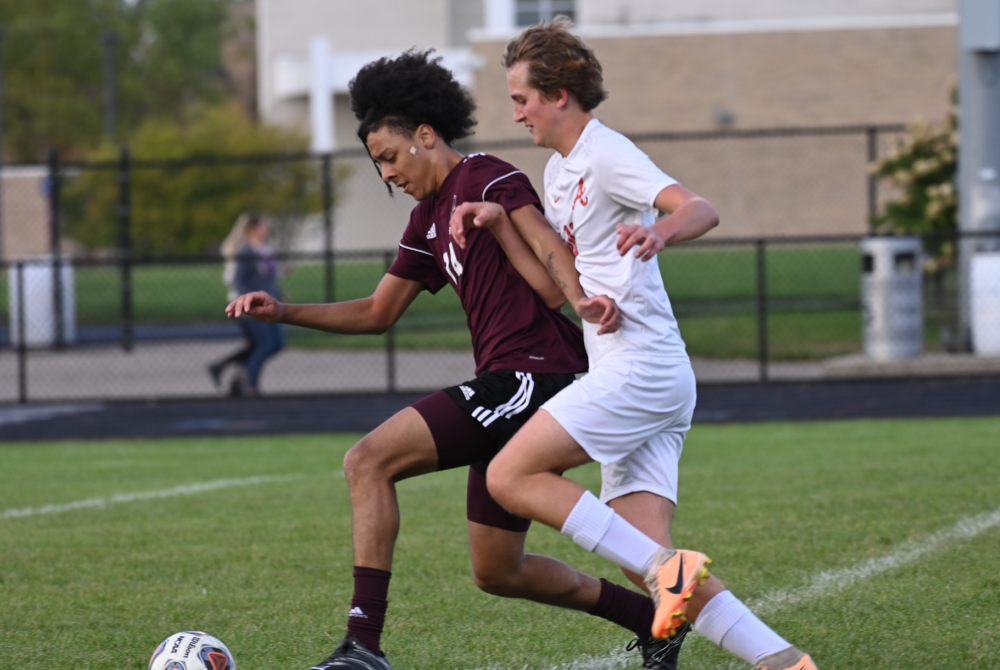
Parchment Team On Verge of Never Playing Putting Off End As Long As Possible
By
Pam Shebest
Special for MHSAA.com
October 17, 2023
PARCHMENT — With just five returning players and no coach, things looked bleak for the Parchment soccer team at the beginning of summer.
 Boy, have things changed.
Boy, have things changed.
Former football offensive line coach Jesse Roder agreed to take the head soccer coach’s job and, with some intensive recruiting, the Panthers not only fielded a team this season but are headed into tonight’s Division 3 District Semifinal with an 11-6-1 record.
Those 11 wins are two more than the last three years combined and make this the first time in 14 years Parchment has had double-digit wins.
In fact, the Panthers’ record over the previous three seasons was 9-41-3 overall.
Athletic director Brennan Davis credits Roder for the turnaround.
“Our first-year coach has done an excellent job creating a positive environment for the team,” Davis said. “He is focused on building character and camaraderie within the program. Academics, participation, relationships, reliability are all important to Coach Roder.”
The players echo those accolades.
Junior goalkeeper Brady Caswell said it was an angry team the past two seasons with a lot of fighting among teammates.
“This year, everyone’s excited to play, ready to play, a little hungry to play, and I love that,” Caswell said. “Everybody works hard, and that’s the big change.
 “You can see it out there. We’re faster, we’re stronger, we have more ambition this year because no one pushed each other before.”
“You can see it out there. We’re faster, we’re stronger, we have more ambition this year because no one pushed each other before.”
He credits the team’s defense for his own success this year.
“That’s one thing that has changed a lot over these last couple years,” the keeper said. “I used to see 20 or 30 shots a game and we’ve cut that down to about half, which gives me a way better chance at saving shots and less chance of getting injured.”
Major choice
Roder had a big decision to make before taking the head coaching job: His son, Brady Newington, is a senior lineman on the Panthers football team.
But Roder, who played soccer in high school while growing up in Garden in the Upper Peninsula, liked the challenge of turning the soccer program around.
Roder, who also coaches powerlifting and track, recruited from those ranks.
“Most of our athletes are first-year soccer players,” he said. “I approached a bunch of my powerlifters and told them I thought it would be right up their alley, so let’s give it a shot, and they did.”
Because of their dismal record the last few years, the Panthers have been underdogs in most of their games this season, including their District Quarterfinal last week, a 2-1 shootout win over South Haven.
“Last year they beat us 8-0,” Roder said. “We knew they were going to be a little confident, but our team’s philosophy starts with, ‘We’re going to outwork everybody in everything we do.’
![Micah Shank [5] steps into a kick.](/sites/default/files/article-images/2023/231017_Parchment_2H3.png) “We do an hour conditioning every day when we have practice. We played 100 minutes of soccer last night, and not a lick of them was tired.”
“We do an hour conditioning every day when we have practice. We played 100 minutes of soccer last night, and not a lick of them was tired.”
Roder also mandates lifting two days a week and has his own solution to any in-team fighting, holding players accountable.
“We have a three-strikes-and-you’re-out rule,” he said. “If you argue with a teammate once and I warn you about it, you’re sent home and you miss the next game.
“Do it again, you miss another game. You do it a third time, you’re off the team.”
The coach has given out just one warning all season.
Key players step up
Freshman Cameron Wagner, who leads the team with 26 goals, made an immediate impact.
“That kid’s vision of the field and his soccer IQ at the age of 15 is leaps and bounds beyond many coaches,” Roden said. “He’s got a real bright future in front of him.”
Wagner and teammate Caden Ragan were selected to the Southwestern Athletic Conference all-conference team Saturday.
Familiar with past Parchment teams, Wagner figured this season would be more of the same.
“I wasn’t going to take it seriously, but thought it would be good for conditioning,” the freshman said.
“Once (the season) started, it became more like a family.”
Wagner credits the coach with his success.
“The coach made me condition a lot, which helped me,” he said. “He changed dribble moves which I couldn’t even think of. At home, now I do the drills he taught me.”
Ragan was the one who fired the winning shot last week.
“I was the fourth (kicker) and I took the (shot) before the other person,” Ragan said. “Brady saved their fourth and saved us the game.”
Roder said the goalkeeper has been strong all season and is the most analytical and intelligent person he has met as far as goalkeeping goes.
![The Panthers’ Cayden Brown [4] defends.](/sites/default/files/article-images/2023/231017_Parchment_2H4.png) “During the game, he watches people and the way they play the ball off their foot,” the coach said. “He sees which way they go with the ball more often than not.
“During the game, he watches people and the way they play the ball off their foot,” the coach said. “He sees which way they go with the ball more often than not.
“So when we got into the shootout situation (in Districts), he actually was telling the ref before he walked up there which way the kid was going to go, and he guessed right every single time. He didn’t get to all the balls, but he still managed to pull off a couple stops which gave us the win.”
Another captain who has been on the team all four years is central defensive midfielder Ty Mulka.
“First two years weren’t the best,” he said. “My friends kept me on the team. This year was our best year.”
If Parchment did not field a team this year, “I was afraid we’d have to merge with our rival school, Comstock,” he said.
The coach said Mulka has been a workhorse.
“He’s been here every single day for everything,” Roder said. “He’s never missed, and he has a relentless work ethic.
“For being a small guy (5-foot-10, 150 pounds) he loves to put a body on people, so he plays a really physical style of soccer. Does a great job seeing the field, and he’s got a laser of a shot.”
Senior center midfielder Wyatt Nieboer said, “I thought 100 percent there would not be a team this year. I found out during the summer.
“I was just happy to play. I knew there was a new coach, and I heard he was really good, which he is, but I didn’t think there was going to be a massive change like there is.”
Roder said Nieboer is a “high energy, a bigger-bodied kid (5-8, 190). His work ethic will not let people beat him. He’s a honey badger.”
Not ready to end
Having tasted success this season, Ragan said the team is not ready to end it.
“The people want to play more,” the junior said. “We’ve had more practices that are actually helping us as a team.
“Things like the weight room are helping build the team and make us stronger, which helps us win games.”
Roder said Ragan, who is one of the captains, has good leadership qualities.
 “He has a natural good touch on the ball,” he said. “He’s very aggressive, very physically dominating. Does a great job going up to get balls, contesting people.”
“He has a natural good touch on the ball,” he said. “He’s very aggressive, very physically dominating. Does a great job going up to get balls, contesting people.”
The Panthers will have a tough test tonight when they host Grand Rapids South Christian (12-4-2), ranked seventh in the state in Division 3 and coming off a bye.
“They’re really good,” Roder said. “They move the ball really, really well. It’s going to be a tough test.
“The kids are excited about soccer around here, and that’s something we want to bring back. We’ve got eight seniors on the squad, probably the last time they’re going to play, so we’re trying to eke out as much time as we can.”
Caswell said all the credit goes to the coach.
“Thank Coach Roder for helping change everything here,” the goalkeeper said. “He’s been one of the biggest parts in changing the culture, changing the team, changing how we play soccer.”
Other seniors on the team are Devin Wilson, Myles Brooks, Kriss Patel, Tyler Lingbeek, Darius Baker and Akhil Veecumsee. Juniors are Keagan Cole, Trey Sukola, Conner Moynihan, Elijah Damron-Webster and Luka Lagina, while sophomores are Tyrone Edwards, Micah Shank, Cayden Brown and Hayden Hose.
 Pam Shebest served as a sportswriter at the Kalamazoo Gazette from 1985-2009 after 11 years part-time with the Gazette while teaching French and English at White Pigeon High School. She can be reached at [email protected] with story ideas for Calhoun, Kalamazoo and Van Buren counties.
Pam Shebest served as a sportswriter at the Kalamazoo Gazette from 1985-2009 after 11 years part-time with the Gazette while teaching French and English at White Pigeon High School. She can be reached at [email protected] with story ideas for Calhoun, Kalamazoo and Van Buren counties.
PHOTOS (Top) Parchment’s Darius Baker, left, controls possession during a game against Allegan. (2) From left: Parchment coach Jesse Roder, Brady Caswell and Caden Ragan. (3) Micah Shank [5] steps into a kick. (4) The Panthers’ Cayden Brown [11] defends. (5) From left: Wyatt Nieboer, Ty Mulka and Cameron Wagner. (Action photos by Shawnia Preston/Oh Shoot Photography, head shots by Pam Shebest.)

